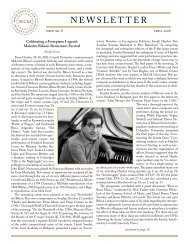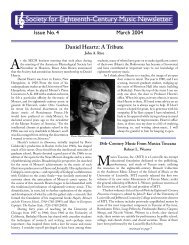NEWSLETTER - Society for 18th-Century Music
NEWSLETTER - Society for 18th-Century Music
NEWSLETTER - Society for 18th-Century Music
Create successful ePaper yourself
Turn your PDF publications into a flip-book with our unique Google optimized e-Paper software.
and welcome any advice <strong>for</strong> those currently searching <strong>for</strong> a position.<br />
Their fears are only escalated by the lack of in<strong>for</strong>mation on<br />
the topic. Open and honest communication between students and<br />
faculty regarding the job search process can only relieve some of<br />
the anxiety shared by students—an anxiety that only adds to an<br />
already nerve-wracking process.<br />
Although we are facing incredibly difficult economic times, it<br />
is important that we understand and respond to concerns shared by<br />
members of the <strong>Society</strong>. Although the present job situation may<br />
be less than ideal, students seeking jobs should remember that<br />
many share similar circumstances. The situation, however, is not<br />
hopeless. A society like SECM exists not only <strong>for</strong> the exchange<br />
of scholarship, but also <strong>for</strong> professional development, networking,<br />
and creating a sense of community. Perhaps in future newsletters<br />
or meetings, we can learn more about how the <strong>Society</strong> can provide<br />
assistance to its student members. Please send comments and<br />
questions to Amber Youell-Fingleton (aly2101@columbia.edu).<br />
D<br />
Paisiello Manuscripts at Brigham Young University<br />
Thomas M. Cimarusti<br />
In 2005 the German music antiquarian firm of Dr. Ulrich Drüner<br />
purchased in Paris a collection of operatic manuscripts devoted to<br />
the works of Giovanni Paisiello (1740-1816). Known as the Talleyrand-Paisiello<br />
Collection, the manuscripts were recently sold<br />
to Brigham Young University, and represent a portion of a larger<br />
Talleyrand <strong>Music</strong> Collection maintained by Drüner and listed in a<br />
recent catalogue (No. 62: Collection Talleyrand). While the Talleyrand-Paisiello<br />
Collection at BYU consists mainly of Paisiello’s<br />
operas, Drüner’s catalogue details a variety of manuscripts, including<br />
some thirty operas of Grétry, first editions of works by<br />
Beethoven, Haydn, and Mozart, and works by Paisiello contemporaries<br />
(Cimarosa, Piccini, and Guglielmi), as well as compositions<br />
by various Talleyrand family members. My purpose here is<br />
to provide a brief overview of the Talleyrand-Paisiello collection<br />
at Brigham Young University.<br />
The Talleyrand name in the collection’s title comes from one of<br />
the most influential families during the eighteenth- and nineteenth<br />
centuries—Charles Maurice Talleyrand (otherwise known as “the<br />
Great Talleyrand”). By 1804 Talleyrand had served Napoleon in<br />
various capacities, acting as Foreign Minister, the Grand Chamberlain,<br />
and Vice-elector of the empire. He later served as the chief<br />
French negotiator <strong>for</strong> the Congress of Vienna and would later sign<br />
the Treaty of Paris. Talleyrand’s uncle was General Louis-Marie<br />
Talleyrand, the French Ambassador to the Kingdom of the Two Sicilies<br />
in Naples and husband to Baroness Marie Louis Fidèle Talleyrand,<br />
founder of the Talleyrand-Paisiello collection in Naples<br />
in 1785.<br />
The Baroness had an intense passion <strong>for</strong> music, one that may<br />
have stimulated an interest in the collection of vocal music. According<br />
to Drüner, the Baroness seems to have “bought all available<br />
operatic manuscripts which were not tied to collections or<br />
libraries.” In addition, she may have acquired other manuscripts<br />
given that she and her son Auguste-Louis (1770–1832) appear to<br />
have been pupils of Paisiello, evident by extant pedagogical manuscripts<br />
with corrections by the composer in the Paris Bibliotèque<br />
nationale as well as several autographs within the Talleyrand-<br />
Paisiello collection. With the death of Auguste in 1832, the Talleyrand-Paisiello<br />
collection became part of the Talleyrand estate, and<br />
was eventually sold to Dr. Drüner, who later sold it to Brigham<br />
Young University.<br />
The Talleyrand-Paisiello collection contains sixty-eight bound<br />
volumes, most of which are bound in half leather with gilt titles<br />
and leather labels bearing the names of either Mademoiselle<br />
Talleyrand or Baroness Talleyrand. The twenty-thousand pages<br />
of music scores include seventeen full scores of complete operas<br />
by Paisiello with additional parts or extracts from thirty-six other<br />
stage works. Of Paisiello’s ninety-two operas, the collection represents<br />
an astonishing fifty-two works <strong>for</strong> the stage. A very small<br />
handful of arias and duets by Cimarosa, Guglielmi, and several<br />
other Paisiello contemporaries can also be found in the collection.<br />
Of all the works contained within the Talleyrand-Paisiello collection,<br />
the third act of Paisiello’s L’astuzie amorose is arguably the<br />
most intriguing considering it is in Paisiello’s hand, and until now<br />
has been missing. With a libretto by Francesco Cerlone, the opera<br />
was first per<strong>for</strong>med in 1775 at the Teatro Nuovo in Naples. The<br />
autograph scores of acts I and II are housed in the Naples Conservatory<br />
(Rari 3.271), and only one other incomplete manuscript<br />
score (found in Torino) and two single numbers from the opera<br />
are extant. A comparison of watermarks and paleography between<br />
Act III of L’astuzie amorose in the Talleyrand-Paisiello collection<br />
with the Naples manuscript strongly suggests that the Talleyrand-<br />
Paisiello collection contains the missing third act of the Naples Act<br />
Portrait of Giovanni Paisiello by Marie Louise Élisabeth Vigée-<br />
Lebrun, 1791<br />
4





